Lesson 69

Learning Objectives
1. What types of environments might I dive in?
2. What six general environmental conditions can affect me while diving?
3. How can I expect depth to affect water temperature?
4. How do I measure (define) visibility as a diver?
5. What four principal factors affect visibility?
6. In what three ways can reduced visibility affect me while diving? What do I do about them?
7. How do I avoid the potential problems of diving in clear water?
8. What two types of water movement primarily affect me as a diver?
9. When diving in a mild current, in what direction would I normally go? Why?
10. What do I do if I’m caught in a current and am carried downstream from where I planned to dive or exit the water?
11. What should I do if I get caught in a surface current while diving from a boat and find myself unable to swim to the boat?
12. What are five types of bottom compositions I’m likely to find
while diving?
13. How do I avoid contact with the bottom? What are three reasons why it is beneficial to avoid bottom contact?
14. How does sunlight affect me as a diver? How can I avoid sunburn?
15. What differences can I expect between diving in fresh water and in salt water?
Types of Dive Environments
One reason diving is popular worldwide is that you can enjoy it in many different aquatic environments, each with its own characteristics. Common popular dive environments include:

- coral reefs
- temperate water oceans
- lakes and reservoirs
- rivers
- springs
- flooded quarries
- human-made dive environments (purpose-built sites, aquariums, etc.)
In all these environments, six general conditions can affect you. The degree to which each condition varies and affects you depends on the environment. Some environments have little temperature change, whereas others have significant changes. Some places never have water movement, others always do and yet others may or may not, depending upon different factors
The six general conditions are:
- temperature
- visibility
- water movement
- bottom composition
- aquatic life
- sunlight
Temperature
Diving takes place in water as cool as near freezing (-2ºC/28ºF – requires special training and equipment) to above 30ºC/85ºF. Most diving takes place in water on the warm end of this range, but thanks to modern exposure suits, often in water much cooler than would otherwise be comfortable.
In many environments, water temperature changes with the season, affecting how much exposure protection you need. Even most tropical environments call for more exposure protection during the winter months. A PADI dive operator where you plan to dive can usually tell you what to expect and suggest appropriate exposure suit choices. Similarly, the web and fellow divers on PADI Club® and other social sites often have information about popular dive destinations, including temperature.
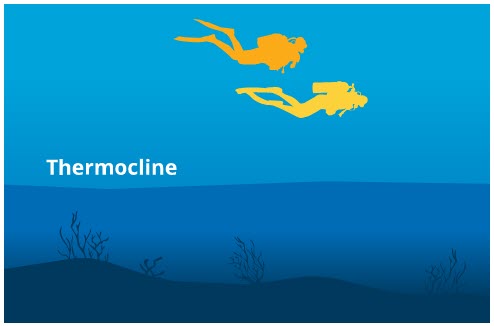
Besides season, depth may affect temperature. In most environments, water gets colder as you go deeper. Water tends to form distinct layers based on temperature. The boundary between a warmer upper layer and a cooler deeper layer is called a thermocline. In still water, like a lake or quarry, it is so distinct that you can stick your hand into noticeably cooler water below while swimming in warmer water.
The depth at which you find a temperature difference depends upon the season and water motion. Some environments, however, like many rivers and springs, are the same temperature at all depths.
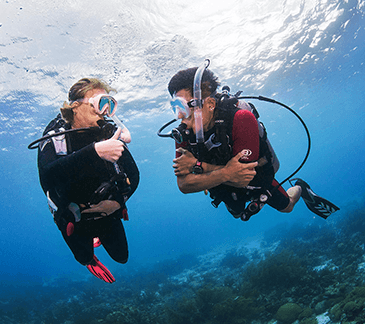
When planning your dive, it is important to base your exposure protection on the temperature at the deepest part of the dive. This is important to avoid hypothermia, but also so you’re comfortable and enjoy the dive. If you find you don’t have enough exposure protection, ascend to shallower, warmer water or abort the dive and return wearing more insulation.
Visibility
Visibility underwater ranges from 0 to more than 60 metres/200 feet and influences your dive significantly. You want to learn how to adjust your dive based on the visibility, how to keep from reducing the visibility by your actions and when visibility is too poor to dive.
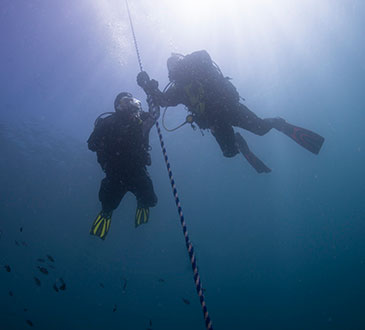
You measure visibility as the distance you can see horizontally underwater. This can be subjective – you may be able to recognize the silhouette of a diver 12 metres/40 feet away, and some would call this 12 metre/40 foot visibility. Others would use a shorter distance at which they can make out the details.
Factors Affecting Visibility
Four principal factors affect visibility at a dive site: water movement, weather, plankton and bottom composition. Each of these affects visibility by increasing or decreasing the amount of suspended particles. Like a dust storm in air, lots of particles in the water means less visibility.
Water movement (waves, current and diver fin kicks) can stir sediment up from the bottom, reducing visibility. Current can improve visibility by carrying away low visibility water and replacing it with clearer water – or vice versa.

The weather can reduce or improve visibility. Wind creates waves (water movement) that stir up the bottom, or rain can cause sediment on land to run off into water. Prolonged offshore wind can push upper water seaward, replacing it with clearer (and cooler) deep water.
Plankton (microscopic organisms suspended in water) can, under some conditions, reproduce rapidly, clouding the water. Sunny weather can accelerate how fast these organisms reproduce.
The nature and composition of particles in the water affects visibility. Whether put in the water by careless fin kicks or natural forces, large, heavy material – like from gravel and rock bottoms – settles out of the water quickly, restoring visibility quickly. Small, light particles – like from mud and clay bottoms – can remain suspended for very long periods.
Diving in Reduced Visibility
Reduced visibility can affect your dive in many ways, but there are three effects in particular to be aware of. The first is that it’s more difficult to stay with your buddy(ies). So, stay close together, take your time and watch each other.
Second, lower visibility may make it harder to track where you are or where you’re going. Use your compass and other navigation references (you’ll learn about navigation in Section Five) to stay oriented.

Third, when descending and ascending, reduced visibility can make you feel disoriented, especially when you can’t see either the bottom or the surface. Avoid this by following a reference down and up (a sloping bottom, mooring line, etc.).
If you must descend or ascend without a reference, as you’ve learned, use your dive computer to help you stay attuned to your depth and descent/ascent rate.
An important point is that reduced visibility doesn’t mean you won’t have a good dive. What you see is more important than how far you see. As you gain experience, you become more comfortable with lower visibility.
Also, the skills you learn in the PADI Underwater Navigator and Search and Recovery Diver courses help you find your way more easily in reduced visibility. But, there is a limit. If the visibility is so poor that you don’t enjoy yourself, can’t accomplish what you want to on the dive or makes diving hazardous in any way, it is best to not dive, or abort if already started.
Diving in Clear Water
Perhaps surprisingly, clear water can also present visibility-related problems. The bottom may seem closer than it really is, so monitor your dive computer as you descend so you don’t exceed your planned depth. Also, because the bottom and the surface may seem closer than they really are, you can experience disorientation and vertigo when descending or ascending without a reference.
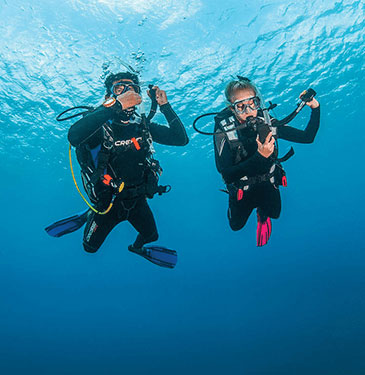
Perhaps the most common problem in clear water is getting too far from your buddy(ies), because you can still see each other. A good rule of thumb is to be able to reach each other within two seconds.
Water Movement
Two types of water motion primarily affect you while diving: waves and current. Waves result primarily from wind blowing over the water’s surface. The stronger the wind and the longer the distance it passes over, the larger waves can grow. Waves affect swimming at the surface, as well as the techniques you use for entering and exiting the water. Small waves (up to 1 metre/3 feet) seldom restrict diving. Larger waves may require more experience and/or training; but even with experience/training, very large waves normally prevent diving.

Currents result from waves, water heating and cooling, the Earth’s rotation and tides. Those caused by waves vary with wind direction. And, because water rises or sinks as it heats or cools, respectively, currents are created that tend to be seasonal. Although such water motion is initially vertical, when it reaches the bottom or an obstacle, the flow can continue horizontally.
Major oceanic currents and countercurrents result from Earth’s rotation. Although these are permanent currents, their paths and strength vary to a degree due to other influences. Tides, which result from the gravitational pull of the sun and moon, lift the oceans and cause water levels to rise and fall as the earth rotates. This process causes currents that flow to and from enclosed areas like bays and harbors.
Diving in Mild Current
You can’t swim against anything but a very weak current without overexerting, so you must use appropriate techniques and avoid all but a mild current.
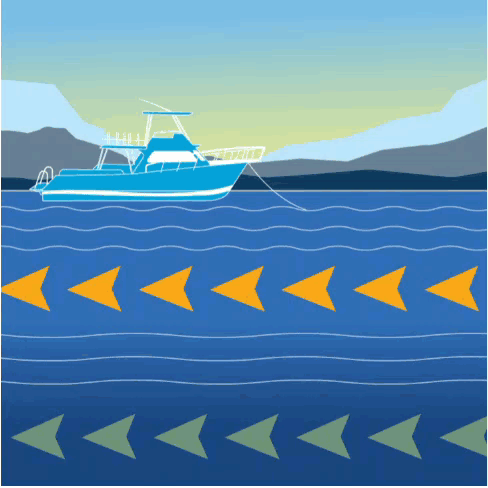
Currents tend to be strongest at the surface and weakest near the bottom, so avoid long surface swims in a current – descend, then swim against the likely milder current on the bottom. Begin a dive in mild current swimming slowly into the current. Do this so that when you turn the dive, the current will push you back to your exit point rather than away from it.
Particularly at the surface, if you get carried past your exit point or planned destination, swim across (perpendicular to) the current to reach shore or a line trailed from a boat, or (in some environments) to get out of the current. Fighting a current by swimming directly into it can exhaust you. When boat diving, if you can’t get to the boat because you’re exhausted (or better, because you’re avoiding exhaustion), remain calm and inflate your BCD (or, drop your weights if you have a BCD problem). Signal the boat with your whistle/inflatable signal tube, etc. to pick you up.
Keep in mind that diving in anything stronger than a mild current requires special training, such as the PADI Drift Diver course.
Bottom Composition
You can divide the different types of bottom compostion into five basic types:
Silt/mud – Clay, fine organic/inorganic material or mud.
Sand – Larger, coarser particles.
Rock – Gravel and larger rock.
Coral – Living and dead coral in tropical water.
Vegetation – Various plants and algae found in both fresh and salt water.

At a given dive site, the bottom may be entirely a single composition, or multiple types, such as sand bottom surrounding coral or rock. Regardless of type, there are at least three benefits to avoiding bottom contact as much as possible.
The first reason is that even with coarse bottoms, contact tends to reduce visibility. So, avoiding contact keeps the water clearer. Second, contact with some bottoms may present hazards. In environments like coral and rock, you can get cuts or scrapes if you’re not careful. In most marine environments, bottom contact has some risk of stings or punctures from organisms like hydroids or sea urchins. Vegetation bottoms like kelp may have some entanglement risk. Avoiding contact reduces these risks. Third, many aquatic organisms that live on the bottom are fragile and sensitive. Resting or kneeling on them, or kicking them with your fin tips, can injure or destroy them. Staying off the bottom helps preserve the site’s natural beauty.
The easiest way to avoid bottom contact is to stay neutrally buoyant and swim well above it. Being properly weighted and trimmed helps, as you’ve learned, because if you’re overweighted you tend to swim with your feet low, which makes it much easier to kick or stir up the bottom. Similarly, on wrecks, avoid contact that would damage or deface them. If possible, rest only on your fin tips, or even with just light finger contact, if you need to make contact on insensitive bottom. Also, stay streamlined and don’t allow your gear to drag.
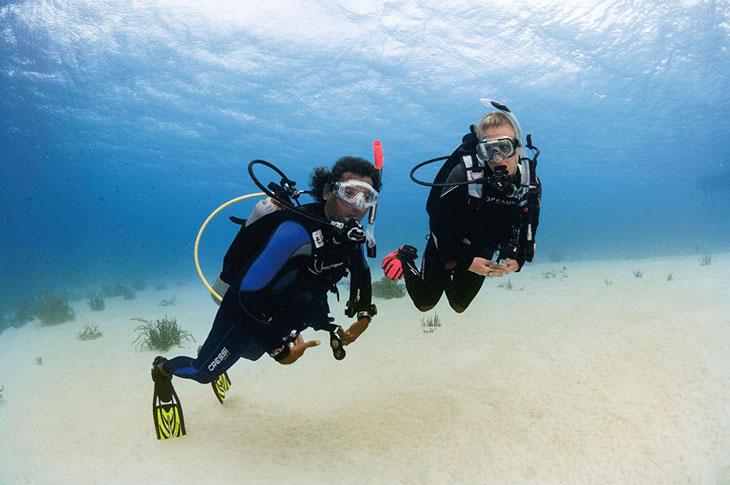
If you must make bottom contact during a dive (there will be times when it’s appropriate), choose an insensitive area (no fragile aquatic life) free of hazards and settle onto it gently. If possible, rest only on your fin tips. Remain aware of the bottom and watch where you put your hands and feet. Entries and exits that involve wading from shore make bottom contact unavoidable. Know what kind of bottom you’ll wade through as you plan your dive. Be prepared for the effect on visibility, sinking into mud, etc. Stop wading and start swimming as soon as the water is deep enough, either by inflating your BCD and surface swimming, or by submerging and swimming underwater. Wear wet suit boots to reduce the risk of aquatic life stings or scrapes/cuts from sharp rocks, etc.
Sunlight
Diving typically takes you into direct sunshine. Besides influencing how much light you have underwater and how warm (or potentially, overheated) you are before and after a dive, it can affect you by causing sunburn. Sunburn can ruin a dive vacation, but you can avoid it entirely.

To prevent sunburn, wear protective clothing and use sunscreen. Stay in the shade as much as possible. Be aware that overcast conditions do not protect you from burning, ultraviolet light. When choosing sunscreens, see your PADI Dive Center or Resort about types specifically designed for divers, with chemicals that won’t affect aquatic life.
Besides sunburn, repeated long-term exposure to the sun can harm your eyes. Like anyone who spends a lot of time outside, protect your eyes with good quality sunglasses.
Fresh Water and Salt Water
There’s great diving in both fresh water (lakes, rivers, quarries) and salt water (all marine environments). In coastal areas, there are dive environments that are both fresh and salt – a shallow freshwater layer over a deeper seawater layer. The basic skills you learn as a diver apply to both environments, but there are some differences. Although there are exceptions, generally:
- Fresh water is less dense and therefore less buoyant than salt. Recheck your weight and trim when going from fresh water to salt or vice versa.
- Marine environments tend to have more types and amounts of aquatic life.
- Very distinct thermoclines (temperature changes) within the recreational diving depth range are more common in fresh water.
- Freshwater environments are more likely to have bottoms that you can stir up easily.
- Marine environments generally have more differences in water motion – currents and waves. For practical purposes, freshwater bodies don’t have tides, whereas tides can significantly affect marine bodies
Overhead Environments
Whether you dive in fresh or salt water, you may encounter places you can swim into that don’t permit you to swim straight up to the surface. Examples include inside shipwrecks, under ice and in caves or caverns. These are called overhead environments. They may appear deceptively safe and simple – but they’re not. They can pose hazards that you may not recognize, nor realize are present, until it’s too late.

Your training in this course prepares you for diving in open water – with direct access to the surface at any time. As soon as you lose the ability to ascend directly to the surface, your risk and the potential hazards go up dramatically. You can learn to dive in these environments safely – but it requires special training and special (often extensive) equipment to handle the added risks and complications.
For this reason, until you have the training and equipment you need, do not enter a cavern, cave, wreck or any other overhead environment. Doing so places you in an unnecessary and extremely hazardous situation. Many overhead environments may seem inviting and safe, but any time you can’t swim directly up to the surface, you’re in a special situation. A sobering thought: One of the leading causes of diver fatalities is going into overhead environments without the proper training and equipment.
Those with proper training and equipment have an excellent safety record in caves, wrecks, under ice and in other overhead environments – those without this training (including otherwise highly trained dive professionals), unfortunately do not.
Avoid this risk entirely. Enjoy the fun and adventure of diving outside the overhead environment. If you’re interested in this type of diving, get the training you need – but stay out until then.
Quick quiz
Module Three

I'll take you diving!
Copyright © Larry Wedgewood Scuba Instruction All Rights Reserved

